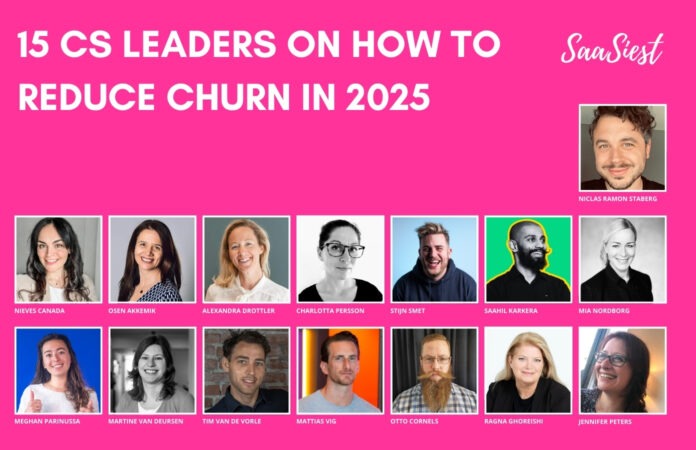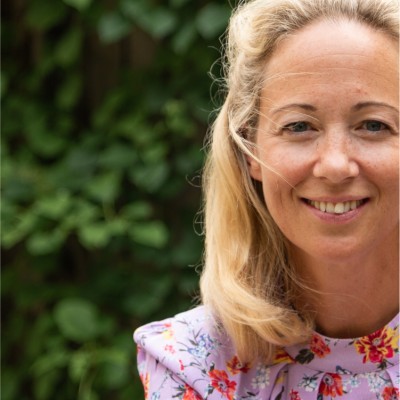Customer churn continues to be one of the toughest hurdles for businesses. But as we approach 2025, the game is changing. Gone are the days of relying solely on metrics or hoping loyalty will follow. Leading CS teams are embracing innovative, human-centered tactics that prioritize customer success, build deep community connections, and leverage tech. To get ahead of the curve, we spoke with 15 top CS leaders to learn about their most impactful strategies for reducing churn in the year ahead.
1. Focus on customer outcomes, Not just KPIs – Move away from traditional success metrics and focus on delivering the outcomes that matter most to your customers. This means getting a deep understanding of their goals and building tailored success plans that clearly tie your product to their business results. When customers see your solution as critical to achieving their objectives, they’re far less likely to churn.
2. Scale with a personal touch – As we embrace more automation and AI, it’s important not to lose the human connection. A successful CS strategy finds the right balance between automation for efficiency and personal, meaningful interactions that make customers feel valued. To me, scalability should apply to all customer segments, from Louch touch to high touch.
3. Foster customer advocacy through community – Everything goes community for a reason. Build strong customer communities and give your users a voice in the evolution of your product. Whether it’s through ambassador programs, exclusive groups, or user-driven feedback initiatives, empowering your customers to share their experiences and insights helps create lasting engagement. This not only reduces churn but also opens doors for organic growth through advocacy.
1. Know your customers, stay close to them not only when renewal is up.
2. Focus on low adoption, understand the reasons and create value well in advance. your customer’s journey is your journey.
3. Make them part of your community. They need to feel that your relationship is beyond a signed contract.
1. Don’t be afraid of churn, as long as it’s expected – Churn will always happen. Some churns will even be healthy churns. Expected churn is good/ok, unexpected churn is not OK. Make sure not to spend time/effort on the wrong customers (e.g., unprofitable customers with no potential/non ICP). Also pay attention to systematic churns and make sure to solve the root cause for these (if they affect customers you want to keep).
2. Customer journey mapping – Make sure you know WHEN and WHERE in the customer journey, moments of delights & pain, pops up. Visualize these and make sure your reps. do whatever they can to make those delight/Aha-moments occur, and make sure you have clear strategies/playbooks for the Pain moments to remove/mitigate these for your beloved customers.
3. Make churn a company wide topic – As CS leader you are responsible to feedback churn reason internally and by that make EVERYONE in your organization accountable for preventing churn. Retention is a company wide effort, starting with New Sales, bringing in the right customers (the right customer fit), Tech/Product is responsible for delivering an awesome, reliable product/service, CS (CSM & Support) is responsible for ensuring customers are getting the full value of your product, Finance to invoice etc. Start rewarding/highlight First Year renewals. A First Year renewal is a big win as it (often) shows that the whole organization has nailed it, something worth celebrating. So that’s my last tip for 2025 – Celebrate more!
1. Proactivity – Prioritize customers and activities that will have the greatest impact, allowing you to focus your efforts on what truly matters. By understanding customer needs, goals and targets you can provide solutions that will help them achieve their desired outcomes. Gain efficiency by using data to identify trends, challenges, and opportunities.
2. Relevancy – Deliver the right service at the right time to the right customers. Instead of focusing solely on account size, tailor your approach based on each customer’s unique potential, needs, and resources. This strategy ensures that your service is personalized and adds real value to your customers.
3. Curiosity – Stay curious about your customers’ success. Don’t just deliver your product or service and move on—continuously check in to see if they are achieving the results they want. This approach not only demonstrates that you care about their outcomes but also helps you adjust your strategy and build a solid insights library.
1. Behavioral segmentation + machine learning – Know who’s going to be a problem before they even realize it themselves. Leverage machine learning to build signals and predict churn risk early. And guess what? In the ChatGPT era, this is way easier than shelling out for some fancy tool. 😉
2. Value alignment + monetization – It’s not enough to show value; tie it directly to ROI. Make sure they see how your product impacts their bottom line, and they’ll stick around because, well, $$$ talks. 💸
3. Community-driven success – Build a killer user community. When customers help each other, they’re more invested—and way less likely to churn. Peer pressure for the win! 😎
1. Know your ICP, work with the GTM team to align and align your GTM motion. You can’t fix the upstream problem downstream.
2. Know what your customers value, know what their boss values, repeatedly drive it and talk about the value they get from your product.
3. Multi-thread!
4. Bonus tip: Empower your CS team with knowledge, tools and the processes they need to mitigate churn.
1. You don’t need 2 years of data to do a churn analysis and it is also not an annual exercise, it should continuously be on your radar.
2. Churn is churn, no excuses. It does not matter if the client went bankrupt, stopped paying or disappeared. There are no categories like finance churn or sales churn, it is all churn. You need to budget for some churn to happen and tackle what you can influence.
3. If you want your org to be involved in churn prevention, try and have your directors or even c-level do at least 1 churn/exit interview per month ( or quarter if you’re in enterprise or don’t have a lot of churn
1. Make sure you identify your churn reasons. For every company, they can be different. An exit interview will help you get more insights into the reasons why customers decide to leave. As soon as you work with churn reasons, you can start having real conversations internally regarding retention strategies.
2. Focus on your governance model. Make sure your product is adopted by multiple stakeholders from different levels at your customer. Set up a meeting calendar on an operational, tactical, and strategic level. Sometimes operational and strategic is enough, depending on the size of your customers. At each level, topics can differ.
3. Customer success (& growth) = customer experience (appropriate) + customer outcome.At Appical we work with an internal and external segmentation based on customers’ needs in service and desired outcomes.
1. Build trust through genuine human interaction – Intelligence and technical skill alone are not enough for a CSM, especially as AI capabilities continue to advance. What AI can’t replace is the human touch—onsite visits, transparent conversations, and casual interactions like small talk at coffee machines. While leveraging your knowledge and solution-oriented skills is crucial, emphasizing personal connections and in-person meetings will strengthen relationships and build trust.
2. Guide Customers Through Change Management – Implementing new software or getting more value out of your product usually comes with a change in organizations. Focus on this component and build trust by sharing best practices, acknowledging that change is challenging, and encouraging your customers along the way by celebrating milestones and by focusing on the end state they want to achieve.
3. Understand the full Tech Stack and workflows of your customer – Does the software integrate with…’. is already on top of RFP’s for many years, but is still too often seen as a checkbox. Go beyond this by gaining a deep understanding of your customer’s entire tech stack and workflows. This will help you see how your software fits into their ecosystem and optimize their processes. That ensures that your solution becomes an indispensable part of their operations and delivers tangible business outcomes.
1.Perceived value -> Proven value – Truly understand what value means for your customers and familiarize yourself with the most important KPI metrics of your ICP.
For example, at GoodHabitz, we are in online learning, and we can demonstrate impact on learning outcomes. Knowing that we work with L&D and HR leaders, focusing on learning alone is no longer enough to stand out. You really need to challenge yourself to prove value through official HR KPIs, such as onboarding time for new employees, employee satisfaction, and corporate well-being.
2. Grinta – This is the mindset that the best professionals in Customer Success have, and I’ve seen that GRINTA is contagious within teams. Yes, there may be a million reasons why this customer is at risk or might churn. But show that you’re eager to do everything possible for the best result so that you can look proudly in the mirror when reflecting on the partnership. When you demonstrate GRINTA, you won’t have any regrets.
3. Catenaccio – This is an Italian word that refers to the art of defense in football. It’s also applicable in Customer Success. In SaaS, we typically build things in a standardized way, but during economically challenging times, customers may have specific requests related to terms and conditions. Listen carefully to the customer and aim for a win-win outcome. You might think accommodating them will cost extra resources, time, or even ARR, but it will pay off in the long run.
1. Implement more metrics that are based on customers’ expectations (and not only your own). The most common one is customer value but go further, like engagement, self-going, development etc.
2. Replace redundant and repetitive tasks/interactions with automated digital approach. To focus the human interactions on the ones bringing actual value and relevancy.
3. Stakeholder mapping and execution. Not having a seat at the table is a big churn risk.
1. Proactive health monitoring – In 2025, deeper integration of AI and predictive analytics will make health scores more precise and actionable in real-time, enabling more proactive customer success interventions.
2. Hyper-personalized customer engagement – By 2025, AI-driven insights will deliver real-time, personalized onboarding and support at scale, making customer journeys more dynamic and reducing the need for additional human resources.
3. Building strong customer communities – What’s likely to evolve is the sophistication of customer communities, moving beyond simple forums or LinkedIn groups to fully integrated networks with AI-powered knowledge sharing and peer-to-peer support by 2025.
1. Listen, listen listen (and do not only pay attention when the renewal is coming up).
Understand what drives value for your customers, understand their strategy, detect what makes your customer successful in their own company and use every possibility to meetup in person to create a bond of trust and honesty. Should you detect a problem with the product/customer fit, make sure this is fed back to Sales & Marketing to adjust the Ideal Customer profile for future customers. Only when your customers have a chance to generate value with your product they will find it useful and will not churn.
2. Know your data by heart – Analyze the customer data (are they successful with your product, what is the adoption; are they using it, which teams are using it, do they use all features or only a few of them etc.), understand competition and the market in depth to see trends and benchmark your customer against the industry; look beyond your customer and think of winning strategies that helped other companies with your product that could be of benefit for your customers. Create benchmarks and warning signals to see early signs of a potential churn in order to prevent it to happen.
3. Partner with your customers to enable their growth – By creating a trustful, growth partnership with your customers you will become an essential partner your customers will not want to miss. Be relentless in understanding what is valuable for your customer and how this can be achieved and keep on coming back to this as it will not be built into stone. Strategies evolve hence expected value will evolve too.
A general tactic that helps to build a sense of belonging and pride is to create a customer community where you let your customers share their success so that they can expand their network too, can learn from others and are confirmed to have taken the right choice with your product. This group feeling is priceless for your brand.
1. Get on top of true customer value – not just product value. Don’t assume that the value of your product is delivered in a vaccuum or a box. As a CS leader, you need to not only think, but execute outside that box and get on top of true customer value. Ask yourself what you can do to provide value to your stakeholders that will make them succeed with their mission in which your product might be a component in, but not the only thing needed to achieve it. Remember, to build a house you might need a hammer, but you also need wood, nails and the right skills to make the most out of it. Winning CS teams need to think and operate this way too. High product adoption in itself is not enough.
2. Anticipate worst case scenario, address it early, and have a plan to deal with it in case it happens. What happens if your customers get a budget cut tomorrow? What happens if a key stakeholder leaves the company? What happens if customer value is objectively lower due to change in volumes (ex: usage or users)? Don’t wait to see what happens – Plan, rehearse, execute.
3. Master CFO relationship. Even if you’re not selling to CFO’s, now you are. Your previous stakeholder might both love and champion your cause internally, but it’s not going to be enough. You need to get on top of the CFO relationship as it’s highly likely that this person will be the biggest gatekeeper for renewed budgets. Demonstrate value in her language, with real numbers, and be ready to defend your cause and commitments to future value from working with your company vs the alternative cost of not doing so.
1. Know your customer’s business case and the expected value they aim to get from your product and keep this up to date. A customer will never churn if they receive more value than what they pay for.
2. Ensure you onboard and activate each customer with a playbook tailored to their specific type and the product you offer. If they are actively using your product, they are more likely to see value—and expand.
3. Make an effort to speak with your customers and identify expansion opportunities. Focus on expanding their use case, rather than just trying to protect revenue.




















